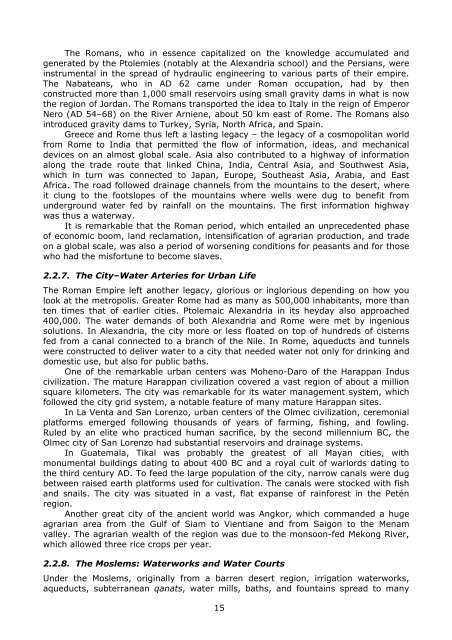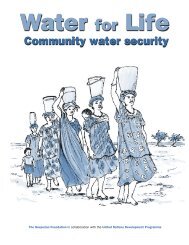Water security and peace: a synthesis of studies ... - unesdoc - Unesco
Water security and peace: a synthesis of studies ... - unesdoc - Unesco
Water security and peace: a synthesis of studies ... - unesdoc - Unesco
Create successful ePaper yourself
Turn your PDF publications into a flip-book with our unique Google optimized e-Paper software.
The Romans, who in essence capitalized on the knowledge accumulated <strong>and</strong><br />
generated by the Ptolemies (notably at the Alex<strong>and</strong>ria school) <strong>and</strong> the Persians, were<br />
instrumental in the spread <strong>of</strong> hydraulic engineering to various parts <strong>of</strong> their empire.<br />
The Nabateans, who in AD 62 came under Roman occupation, had by then<br />
constructed more than 1,000 small reservoirs using small gravity dams in what is now<br />
the region <strong>of</strong> Jordan. The Romans transported the idea to Italy in the reign <strong>of</strong> Emperor<br />
Nero (AD 54–68) on the River Arniene, about 50 km east <strong>of</strong> Rome. The Romans also<br />
introduced gravity dams to Turkey, Syria, North Africa, <strong>and</strong> Spain.<br />
Greece <strong>and</strong> Rome thus left a lasting legacy – the legacy <strong>of</strong> a cosmopolitan world<br />
from Rome to India that permitted the flow <strong>of</strong> information, ideas, <strong>and</strong> mechanical<br />
devices on an almost global scale. Asia also contributed to a highway <strong>of</strong> information<br />
along the trade route that linked China, India, Central Asia, <strong>and</strong> Southwest Asia,<br />
which in turn was connected to Japan, Europe, Southeast Asia, Arabia, <strong>and</strong> East<br />
Africa. The road followed drainage channels from the mountains to the desert, where<br />
it clung to the footslopes <strong>of</strong> the mountains where wells were dug to benefit from<br />
underground water fed by rainfall on the mountains. The first information highway<br />
was thus a waterway.<br />
It is remarkable that the Roman period, which entailed an unprecedented phase<br />
<strong>of</strong> economic boom, l<strong>and</strong> reclamation, intensification <strong>of</strong> agrarian production, <strong>and</strong> trade<br />
on a global scale, was also a period <strong>of</strong> worsening conditions for peasants <strong>and</strong> for those<br />
who had the misfortune to become slaves.<br />
2.2.7. The City–<strong>Water</strong> Arteries for Urban Life<br />
The Roman Empire left another legacy, glorious or inglorious depending on how you<br />
look at the metropolis. Greater Rome had as many as 500,000 inhabitants, more than<br />
ten times that <strong>of</strong> earlier cities. Ptolemaic Alex<strong>and</strong>ria in its heyday also approached<br />
400,000. The water dem<strong>and</strong>s <strong>of</strong> both Alex<strong>and</strong>ria <strong>and</strong> Rome were met by ingenious<br />
solutions. In Alex<strong>and</strong>ria, the city more or less floated on top <strong>of</strong> hundreds <strong>of</strong> cisterns<br />
fed from a canal connected to a branch <strong>of</strong> the Nile. In Rome, aqueducts <strong>and</strong> tunnels<br />
were constructed to deliver water to a city that needed water not only for drinking <strong>and</strong><br />
domestic use, but also for public baths.<br />
One <strong>of</strong> the remarkable urban centers was Moheno-Daro <strong>of</strong> the Harappan Indus<br />
civilization. The mature Harappan civilization covered a vast region <strong>of</strong> about a million<br />
square kilometers. The city was remarkable for its water management system, which<br />
followed the city grid system, a notable feature <strong>of</strong> many mature Harappan sites.<br />
In La Venta <strong>and</strong> San Lorenzo, urban centers <strong>of</strong> the Olmec civilization, ceremonial<br />
platforms emerged following thous<strong>and</strong>s <strong>of</strong> years <strong>of</strong> farming, fishing, <strong>and</strong> fowling.<br />
Ruled by an elite who practiced human sacrifice, by the second millennium BC, the<br />
Olmec city <strong>of</strong> San Lorenzo had substantial reservoirs <strong>and</strong> drainage systems.<br />
In Guatemala, Tikal was probably the greatest <strong>of</strong> all Mayan cities, with<br />
monumental buildings dating to about 400 BC <strong>and</strong> a royal cult <strong>of</strong> warlords dating to<br />
the third century AD. To feed the large population <strong>of</strong> the city, narrow canals were dug<br />
between raised earth platforms used for cultivation. The canals were stocked with fish<br />
<strong>and</strong> snails. The city was situated in a vast, flat expanse <strong>of</strong> rainforest in the Petén<br />
region.<br />
Another great city <strong>of</strong> the ancient world was Angkor, which comm<strong>and</strong>ed a huge<br />
agrarian area from the Gulf <strong>of</strong> Siam to Vientiane <strong>and</strong> from Saigon to the Menam<br />
valley. The agrarian wealth <strong>of</strong> the region was due to the monsoon-fed Mekong River,<br />
which allowed three rice crops per year.<br />
2.2.8. The Moslems: <strong>Water</strong>works <strong>and</strong> <strong>Water</strong> Courts<br />
Under the Moslems, originally from a barren desert region, irrigation waterworks,<br />
aqueducts, subterranean qanats, water mills, baths, <strong>and</strong> fountains spread to many<br />
15
















